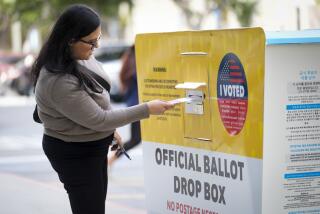May Reform Set the DWP Free
- Share via
Charter reform provides the last, best chance for Los Angeles’ public power system to be truly competitive.
The issue is whether the municipally owned Los Angeles Department of Water and Power can act with the speed and efficiency of a private company or will it continue to be shackled with all the layers of being a city department. Those layers include the mayor, 15 City Council members, five DWP commissioners, a chief legislative analyst and staff, a city administrative officer and staff, the city controller, the city attorney and more.
The answer is simple: DWP cannot continue under the present governance and survive.
Like the telephone companies, airlines and railroads before us, competition in the electric utility industry is ushering in a new competitive era that will be in full force by 2002. DWP must be ready to respond.
To move ahead into the competitive market, the agency must transform itself from a monopoly into a highly effective competitor. Already steps have been taken. An action plan, approved by the City Council in March, provides a framework for turning the DWP into a lean, efficient organization. The DWP is lowering its costs, reducing staff, growing revenue opportunities and providing for an aggressive debt reduction plan to pay down more than $4 billion in debt by 2002.
Yet the crucial issue remains: For DWP to be successful when competition becomes real in 2002, it must overcome the burden of an antiquated governance system. The decision-making structure is designed to control a monopoly, not to provide the flexibility required to operate effectively in an open market.
There is no utility in America with more layers in the approval process than the DWP. Where is there another utility competitor in which the company’s CEO does not have control over the hiring or firing of its management, the salaries of its employees or even its own legal counsel or lobbyists? Even bills are paid by an entity outside of DWP’s control.
Civil Service rules restrain initiative and enterprise. As a practical matter, the DWP is virtually dependent on city services to control all its basic business functions.
The overall objective must be to create a public power entity that has the flexibility and efficiency of a private company, yet remains responsible to the public and to a public board for setting its policy. As a public utility, the DWP has a responsibility to act in the best interest of its owners--the people of Los Angeles--and to provide low rates as well as to honor public purposes such as protecting the environment and encouraging economic development in the city.
The good news is that change is already in the works. It is widely recognized that the City Charter, created in 1925, is in drastic need of reform. The DWP must be placed under a single board and freed from all the shackles of city government.
The board would consist of two directors appointed by the mayor, two directors appointed by the City Council and three elected directors. This would give the mayor, the City Council and the people of Los Angeles a voice in the DWP’s operation and it would also streamline levels of authority.
The board of directors would select the DWP’s general manager; it would require five votes to fire him or her. The utility would have its own procurement and personnel systems, its own lawyers and lobbyist.
DWP management would make all operating decisions, subject to a board-approved budget. The board also would directly hold the general manager accountable and give him or her the authority to take risks and to develop an entrepreneurial enterprise.
Rates and decisions to sell or acquire significant assets still would require City Council approval. As a dividend and in lieu of property taxes, the DWP should be required to pay 5% of its revenues to the city, its owner.
A board of directors with sole authority and a DWP management staff empowered to do its job could make all this happen.
The citizens of Los Angeles have an important stake in their utility. If the DWP is to remain a viable business that is able to compete in the deregulated marketplace in 2002 and beyond, the handcuffs of a cumbersome governance system must be removed.
More to Read
Sign up for Essential California
The most important California stories and recommendations in your inbox every morning.
You may occasionally receive promotional content from the Los Angeles Times.










